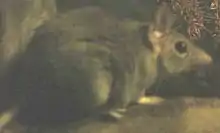| Fawn antechinus[1] | |
|---|---|
 | |
| Scientific classification | |
| Domain: | Eukaryota |
| Kingdom: | Animalia |
| Phylum: | Chordata |
| Class: | Mammalia |
| Infraclass: | Marsupialia |
| Order: | Dasyuromorphia |
| Family: | Dasyuridae |
| Genus: | Antechinus |
| Species: | A. bellus |
| Binomial name | |
| Antechinus bellus (Thomas, 1904) | |
 | |
| Distribution of the fawn antechinus | |
The fawn antechinus (Antechinus bellus) is a species of small carnivorous marsupial found in northern Australia. It is the only Antechinus to be found in the Northern Territory and has a patchy, restricted range.
Taxonomy
The earliest scientific collection of a fawn antechinus was made by John T. Tunney,[3] and the first zoological description was made in 1904 by the renowned biologist Oldfield Thomas, who gave it the species name bellus, meaning beautiful.[4] It has never been confused with other species.
It is a member of the family Dasyuridae and of the genus Antechinus (meaning "hedgehog-equivalent"), which has nine other members.
Description
The fawn antechinus is unique among antechinuses, being considerably paler than many of its relatives. It is a light grey colour and is distinguished from the only other similar species in the area where it lives (the sandstone dibbler and the red-cheeked dunnart) by its larger size and paler colouring. It is insectivorous and, like many of its relatives, all of the males die after the breeding season.[5]
The fawn antechinus has a breeding season during August. Young are born in September–October in litters of up to ten, and are usually weaned by January.[5]
Distribution and habitat
The fawn antechinus is found in the Top End of the Northern Territory, where it was once fairly common.[4] It inhabits tall, fairly open forest in the tropics. Populations have declined substantially since European colonisation, with one study in the Northern Territory finding a 20% reduction in the extent of occurrence of and a 45% reduction in the breadth of occupied environmental space.[6]
In Aboriginal language and culture
The Kunwinjku people of western Arnhem Land call this animal mulbbu, as they do many small marsupials and rodents.[7][8][9]
References
- ↑ Groves, C. P. (2005). Wilson, D. E.; Reeder, D. M. (eds.). Mammal Species of the World: A Taxonomic and Geographic Reference (3rd ed.). Baltimore: Johns Hopkins University Press. p. 29. ISBN 0-801-88221-4. OCLC 62265494.
- ↑ "IUCN World Conservation congress, 2016". Archived from the original on 8 September 2016. Retrieved 9 September 2016.
- ↑ Kristofer M. Helgen; Roberto Portela Miguez; James Kohen; Lauren Helgen (2012). "Twentieth century occurrence of the Long-Beaked Echidna Zaglossus bruijnii in the Kimberley region of Australia". ZooKeys (255): 103–132. doi:10.3897/zookeys.255.3774. PMC 3560862. PMID 23459668.
- 1 2 Calaby, J.H. (1995). "Fawn Antechinus". In Strahan, Ronald (ed.). The Mammals of Australia. Reed Books. pp. 85–86.
- 1 2 Menkhorst, Peter (2001). A Field Guide to the Mammals of Australia. Oxford University Press. p. 54.
- ↑ von Takach, Brenton; Scheele, Ben C.; Moore, Harry; Murphy, Brett P.; Banks, Sam C. (2020). "Patterns of niche contraction identify vital refuge areas for declining mammals". Diversity and Distributions. 26 (11): 1467–1482. doi:10.1111/ddi.13145. hdl:1885/286535. ISSN 1366-9516.
- ↑ Garde, Murray. "mulbbu". Bininj Kunwok Online Dictionary. Bininj Kunwok Regional Language Centre. Retrieved 31 October 2021.
- ↑ Goodfellow, D. (1993). Fauna of Kakadu and the Top End. Wakefield Press. p. 21. ISBN 1862543062.
- ↑ "Various Rock Dwelling Dasyurids". Bininj Kunwok Names for Plants and Animals. Bininj Kunwok Language Project. Retrieved 31 October 2021.
